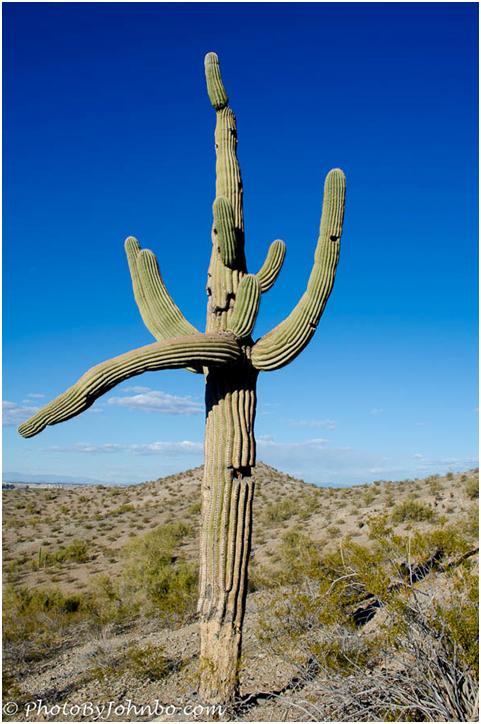Sonoran Desert, Arizona.
This week, Jen H. asks us to think about the new year, “anticipate beginnings, changes, and opportunities for growth” in this week’s challenge. You can read her entire challenge post here.
Having recently returned to Arizona after leaving Fargo North Dakota’s cold winter, this challenge reminded me of the iconic succulent that only grows in the Sonoran Desert. The saguaro (suh-wahr-oh) cactus is a long-lived variety and it’s shape in a photograph instantly identifies the location in the great southwest. The Sonoran Desert covers southern Arizona, extreme southeastern California and northern Mexico.
![]() A young saguaro (the taller, more slender cactus on the right) grows slowly, this specimen is between 24 and 30 inches (60-75 cm) tall. The first decade in a saguaro’s life might only see growth of two inches (5 cm). The individual in the photo above is probably 30 years old or more. Don’t confuse the younger saguaro with the similar fire barrel cactus. Fire barrel cactus only grow a few feet high, have longer, more curved needles than a saguaro and have a purplish spiral appearance. As seen in the image below, the saguaro pleats are vertical and the short spikes radiate from the high points on the pleats.
A young saguaro (the taller, more slender cactus on the right) grows slowly, this specimen is between 24 and 30 inches (60-75 cm) tall. The first decade in a saguaro’s life might only see growth of two inches (5 cm). The individual in the photo above is probably 30 years old or more. Don’t confuse the younger saguaro with the similar fire barrel cactus. Fire barrel cactus only grow a few feet high, have longer, more curved needles than a saguaro and have a purplish spiral appearance. As seen in the image below, the saguaro pleats are vertical and the short spikes radiate from the high points on the pleats.
Though the “typical” saguaro is depicted with two arms in popular illustrations, the appendages don’t start appearing until the plant is somewhere around 7 decades old. The example below is typical of new arm growth and is probably 80 or more years of age.
In reality, the number of arms increases with age and it’s common to find specimens over two centuries old. The multiple arms don’t always point skyward as in this example below.
 Older plants often show the appearance of much damage as does this example. The saguaro is a favorite nesting home of the Gila Woodpecker, the openings created by the woodpecker’s long beak. The excavated cavities are called “boots” where, inside the cactus, the chicks can stay safe and cool in the hot desert environment. Other birds, such as owls and kestrels are known to use abandoned gila woodpecker nests to raise their own young as well.
Older plants often show the appearance of much damage as does this example. The saguaro is a favorite nesting home of the Gila Woodpecker, the openings created by the woodpecker’s long beak. The excavated cavities are called “boots” where, inside the cactus, the chicks can stay safe and cool in the hot desert environment. Other birds, such as owls and kestrels are known to use abandoned gila woodpecker nests to raise their own young as well.
 As to maximum growth, the two giant saguaro in the image above probably reach between 40 and 60 feet (12-18 m), typical for the species which is the largest cactus variety found in the United States. The image above features my wife on a cool Arizona winter day standing next to two very old saguaro that happen to be living next to the Rainbow Valley Trail in Estrella Mountain Regional Park in Goodyear, Arizona. You can find more information and images of the mighty saguaro in an earlier post of mine here.
As to maximum growth, the two giant saguaro in the image above probably reach between 40 and 60 feet (12-18 m), typical for the species which is the largest cactus variety found in the United States. The image above features my wife on a cool Arizona winter day standing next to two very old saguaro that happen to be living next to the Rainbow Valley Trail in Estrella Mountain Regional Park in Goodyear, Arizona. You can find more information and images of the mighty saguaro in an earlier post of mine here.
May you enjoy much personal growth in the new year.
John Steiner


It’s amazing how big those cacti grow! It’s also a testament to how tough they are when you see up close the sheer amount of damage they can sustain from their aviary friends…
Indeed. One of my favorite things about Arizona. They symbolize the state even tough they are not found much further north than Phoenix.
Amazing to think that they can be that long-lived in such a harsh environment!
[…] Journeys with Johnbo Weekly Photo Challenge – Growth […]